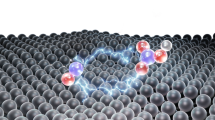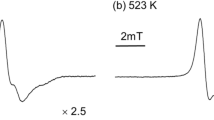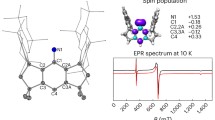Abstract
ELECTRON spin resonance (ESR) spectroscopy provides the best readily available method for detecting free radicals in reacting systems. Stable free radicals can be detected at concentrations as low as 10−8 M with commercially available equipment. Special techniques, however, are necessary for the direct detection of short lived free radicals (for example, flow systems). Recently an indirect ESR method of detecting short lived free radicals in solution has been developed which involves free radical addition to a nitroso function, for example, 2-nitroso-2-methylpropane1, or a nitrone function, for example, phenyl N-t-butyl nitrone2–5. The reaction produces stable nitroxides which build up to readily detectable concentrations in the presence of a free radical source. The general usefulness of the nitrone has been found to exceed that of the nitroso compound because of its greater stability in a variety of reaction conditions. Most work has been done with phenyl N-t-butyl nitrone (PBN) in solution3–5. The free radical addition reaction is called a spin trapping reaction. The nitrone or nitroso compound is called a “spin trap” and the radical addition product is called a “spin adduct”. In this report we describe our first results on the trapping of free radicals in the gas phase.
This is a preview of subscription content, access via your institution
Access options
Subscribe to this journal
Receive 51 print issues and online access
$199.00 per year
only $3.90 per issue
Buy this article
- Purchase on SpringerLink
- Instant access to full article PDF
Prices may be subject to local taxes which are calculated during checkout
Similar content being viewed by others
References
Mackor, A., Wajer, Th. A. J. W., and DeBoer, Th. J., Tetrahedron, 1623 (1967); Mackor, A., Wajer, Th. A. J. W., DeBoer, Th. J., and van Voorst, J. D. W., Tetrahedron Lett., 385, 2115 (1966); Lagercrantz, C., and Forshult, S., Nature, 218, 1247 (1968); Chalfont, G. R., Perkins, M. J., and Horsfield, A., J. Amer. Chem. Soc., 90, 7141 (1968).
Iwamura, M., and Inamoto, N., Bull. Chem. Soc. Japan, 40, 702 (1967).
Janzen, E. G., and Blackburn, B. J., J. Amer. Chem. Soc., 90, 5909 (1968).
Janzen, E. G., and Blackburn, B. J., J. Amer. Chem. Soc. (in the press, to appear in July 1969).
Janzen, E. G., Maender, O. W., and Knauer, B., Abstracts of Papers, 157th National ACS Meeting, Minneapolis, Minn., April 13–18, 1969.
Author information
Authors and Affiliations
Rights and permissions
About this article
Cite this article
JANZEN, E., GERLOCK, J. Detection of Gas Phase Free Radicals by Electron Spin Resonance Spin Trapping Techniques. Nature 222, 867–868 (1969). https://doi.org/10.1038/222867b0
Received:
Issue date:
DOI: https://doi.org/10.1038/222867b0
This article is cited by
-
Free Radicals in Tobacco Smoke
Nature (1971)



